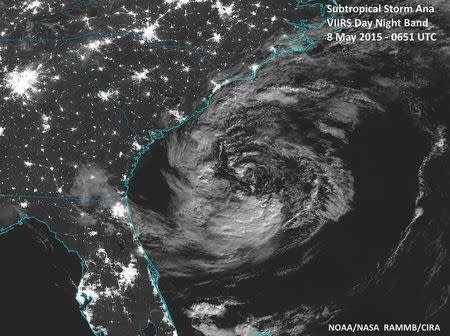Tropical storm warning expanded for Carolinas as Ana strengthens
By David Adams MIAMI (Reuters) - Meteorologists expanded a tropical storm warning for part of the North Carolina and South Caroline coastline on Friday, according to the U.S. National Hurricane Center. Subtropical storm Ana, the first named storm of the 2015 Atlantic hurricane season, was on the verge of becoming a tropical storm with maximum sustained winds of 45 miles per hour (72 km per hour), according to the Miami-based weather agency announced. A warning is now in effect for areas from South Santee River, South Carolina to Cape Lookout, North Carolina, at the southern end of the Outer Banks, it said. Forecasts show the system making landfall on Sunday near the border between North and South Carolina, with 50-55 miles per hour (80-88 km/h) winds. Ana should remain near or over the warm waters of the Gulf Stream current, the hurricane center said, before weakening as it approached the coast. It stalled on Friday about 165 miles (265 km) south-southeast of Myrtle Beach, a South Carolina beach and golfing resort, but was expected to strengthen slightly as it approached the coast. Ana's formation is the earliest appearance of a named storm in the Atlantic since a previous incarnation of Subtropical Storm Ana on April 20, 2003, said Jeff Masters, chief meteorologist for Weather Underground, a commercial weather service. The Atlantic hurricane season typically runs from June 1 through Nov. 30. Subtropical and tropical storms do not generate very different wind strengths, but tropical storms cause more rain and have the potential to rapidly intensify into hurricanes, said Masters. Forecasters with Colorado State University predicted in April that the Atlantic Ocean will see a "well below average" number of hurricanes this season due to cooler Caribbean waters and the El Niño effect. El Niño, a warming of sea-surface temperatures in the Pacific, increases the odds of a quiet Atlantic hurricane season. El Niño typically brings high wind shear to the tropical Atlantic, disrupting hurricanes as they try to form. (Reporting by David Adams in Miami and Kevin Jose in Bengaluru; Editing by Chizu Nomiyama, G Crosse and Jonathan Oatis)



